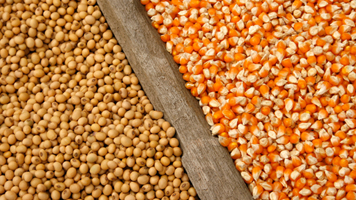On the Horizon: Huge Corn and Soy Crops, Low Market Prices
Category: Grains, Miscellaneous, Oilseeds
 (Agriculture.com) – The U.S. corn and soybean crops will be slightly larger than expected, mammoth production that would assure lackluster commodity prices far into 2018, according to a USDA survey of growers. With normal weather and yields, the corn and soybean harvests would be the second largest on record and would be piled on top of stockpiles that have been growing since the 2012 drought.
(Agriculture.com) – The U.S. corn and soybean crops will be slightly larger than expected, mammoth production that would assure lackluster commodity prices far into 2018, according to a USDA survey of growers. With normal weather and yields, the corn and soybean harvests would be the second largest on record and would be piled on top of stockpiles that have been growing since the 2012 drought.
Commodity prices have a distant relationship with food prices. Farmers receive less than 16 cents from each $1 spent on food, estimates USDA; the rest goes to shippers, processors, and retailers. Food prices are forecast to rise 1.5% this year, the third year in a row of modest increases compared with the 20-year food inflation average of 2.5%. The overall U.S. inflation rate is expected to be 1.6% to 1.9% this year.
Corn and soybeans are the two most widely planted U.S. crops and would account for 56% of the land devoted to the 19 “principal” crops in the country, from food and feed grains to sugar beets, hay, and tobacco. Corn and soybeans are the foundation of livestock rations, are raw ingredients for many foods, and have myriad industrial uses including feedstock for biofuels.
For its annual Acreage Report, the USDA surveyed nearly 70,000 producers and spot-checked 11,000 fields during the first two weeks of June to estimate soybean plantings of a record 88.7 million acres, up 7% from the old mark set last year, and corn plantings of 90.9 million acres, down 3% from 2016. The corn crop could total 14.25 billion bushels, and soybeans could come in at 4.26 billion bushels, based on USDA’s projections for harvest area and yields. Corn and soybean production set records last year.
Some 5.23 billion bushels of corn and 963 million bushels of soybeans are in storage, with the figure for each 11% larger than this point a year ago, said USDA in its quarterly Grain Stocks Report, released at the same time as the Planting Report.
Market prices for the three major U.S. crops — corn, wheat, and soybeans — set record highs following the 2012 drought and collapsed in 2013 as global output rebounded. They have run at comparatively low levels since, with few signs of a rebound in the near term. The USDA and CBO separately have projected an average price of $3.40 a bushel for this year’s corn crop and $9.30 a bushel for soybeans.
Low crop prices, a boon to livestock producers, have pulled down farmer income. Due to cash reserves built during the commodity boom that ran from 2006 to 2013, farm solvency remains strong, although the debt-to-asset ratio, a commonly used gauge of financial stress, is forecast this year to be the highest since 2002.
In the USDA survey conducted at the end of the planting season, growers indicated they planted 890,000 more acres of corn and 31,000 more acres of soybeans than they planned in March, weeks before they began fieldwork. The additional land will boost the size of the crops, barring bad weather or poor yields. One consultancy says the corn crop would average 157.5 bushels an acre based on conditions so far, well below USDA’s projection of 170.7 bushels an acre. Many analysts say weather during July, when corn goes its reproductive stage, is the deciding factor in yields.
At the same time that big corn and soybean crops are in the offing, wheat plantings are the smallest since USDA began recording them in 1919 — 45.7 million acres and 9% smaller than last year. The wheat harvest, at 1.8 billion bushels, would be half a billion bushels smaller than the 2016 crop and begin to cut into the six-month supply now in U.S. bins.
Drought in the Northern Plains is amplifying the impact of smaller-than-expected plantings of spring wheat. “The drought in the United States has propelled prices for the high- protein grain that is prized by breadmakers to three-year highs,” said Reuters.




